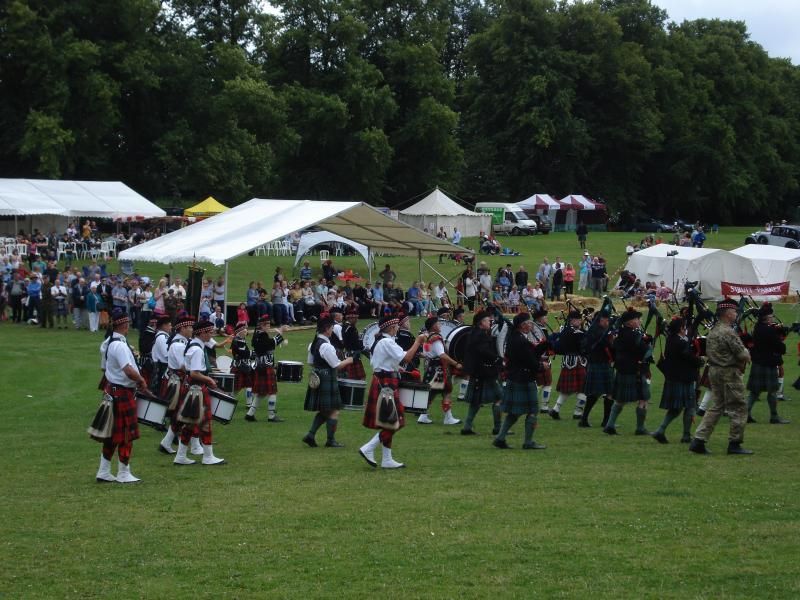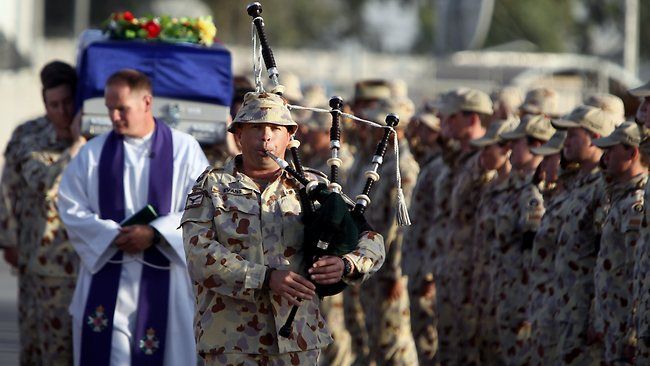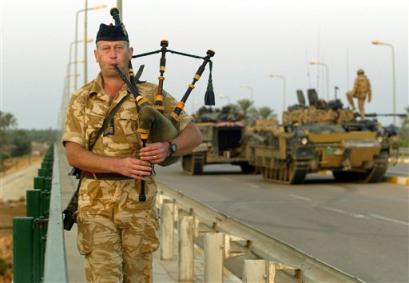|
-
14th July 14, 02:48 AM
#1
Highland Regiment Uniforms When Deployed...Then And Now
I saw @OC Richard post a neat thread about his new spats for his impression of a pipe major from the Black Watch (fabulous job, by the way, sir). It got me thinking.
What would a pipe major in the Highland regiments wear when deploying abroad through the years?
What would they wear now?
Would they defer to another MOS (military occupational specialty; I don't know the correct terminology used in the British or Commonwealth armed services) and lay down their pipes when deployed?
Thanks, gents.
The Official [BREN]
-
-
14th July 14, 03:11 AM
#2
Well this chap managed to wear this in the Western Desert, and very close to the action by the looks of it, probably in 1942. Look very closely at the men surrounding the piper, I find this picture to be one of the most telling war pictures that I have ever seen.

I think today, as then and before, pipers in particular and bandsmen of Scottish Regiments managed to get their kilts and instruments pretty near the front whenever possible.The kilt was foresaken, as battle dress, officialy by the War Office for Highland Regiments in 1940. The Cameron Highlanders were the last Regiment to wear the kilt in battle (France 1940). I do note though that these days the pipes seem to get through to the front , well if the photographs are anything to go by, but not the kilt. It is not forgotten by modern day Commanding Officers of Scots Regiments that the pipes have a huge morale boosting effect on their men.
Last edited by Jock Scot; 28th July 14 at 03:51 AM.
Reason: added an important omission.
" Rules are for the guidance of wise men and the adherence of idle minds and minor tyrants". Field Marshal Lord Slim.
-
The Following 9 Users say 'Aye' to Jock Scot For This Useful Post:
-
14th July 14, 04:05 AM
#3
Pipers are soldiers first and foremost, unlike military bandsmen.
Depends on the regiment, but in one the Pipes & Drums may be the Fire Support Platoon (heavy machine gun platoon) and in another a Mortar Platoon. Some may be employed as drivers, others as combat medics.
They pretty much wear the same as everybody else, although when in ordinary headwear, the pipers will often wear their plain coloured glengarries.
-
The Following User Says 'Aye' to Ron Abbott For This Useful Post:
-
14th July 14, 07:41 AM
#4
That is a fantastic photograph. Thank you for posting it.
-
The Following 2 Users say 'Aye' to tulloch For This Useful Post:
-
14th July 14, 07:50 AM
#5
Harpenden, yesterday. The piper on the right only returned from Afghanistan last week.

Last edited by Chas; 15th July 14 at 03:25 PM.
-
The Following 4 Users say 'Aye' to Chas For This Useful Post:
-
14th July 14, 10:51 AM
#6
Sgt Darren Evans of the Australian Army, pipes at a ramp ceremony in Afganistan. Photo by Gary Ramage

Shoot straight you bastards. Don't make a mess of it. Harry (Breaker) Harbord Morant - Bushveldt Carbineers
-
The Following 7 Users say 'Aye' to Downunder Kilt For This Useful Post:
-
15th July 14, 01:55 PM
#7
Thank you for your replies, gentlemen. Very informative.
The Official [BREN]
-
-
19th July 14, 02:47 PM
#8
Infantry battalion bandsmen, including pipers and drummers, are often employed as stretcher bearers.
"At Festubert in June, 1915, the pipers of the 6th Seaforths worked continuously day and night, and brought 170 casualties from the front line to the dressing station; at Loos the 9th Black Watch lost nearly all their pipers when similarly engaged, and at the two actions of Loos and Neuve Chapelle the 6th Gordons had two killed and ten wounded."
Last edited by Bruce Scott; 19th July 14 at 03:10 PM.
-
The Following User Says 'Aye' to Bruce Scott For This Useful Post:
-
28th July 14, 03:19 AM
#9
 Originally Posted by TheOfficialBren

What would a pipe major in the Highland regiments wear when deploying abroad through the years?
Wow 'through the years' covers a lot of territory!
In the 18th century and early 19th century the dress of the pipers varied by regiment. Their dress breaks down into three basic categories:
1) Pipers dressed like the other soldiers; red jackets etc.
2) Pipers dressed like bandsmen; this could mean jackets in "reversed colours" (the body of the jacket being the regiment's facing colour) or white jackets, and large decorative wings on the shoulders, etc.
3) Pipers dressed in kit like they would wear as civilian pipers employed by aristocracy, that is, in livery; this could include tartan jackets (as in The Black Watch).
The third option provided the entire kit adopted for the pipers of the Cameron Highlanders in the 1840s, originally purely civilian: Glengarry, doublet, and wide black waistbelt and crossbelt with silver fitments. The doublet was green, the Cameron Highlanders' facing colour, keeping alive the tradition in some regiments of having pipers in the same 'reversed colours' jackets as the other musicians. This kit was later copied by the other Highland regiments (even the green of the doublets, though the other regiments had other facing colours). Ironically we think of those very civilian things adopted for the Cameron pipers, nowadays, as being 'military'.
One thing to keep in mind is that for a very long time soldiers wore the same uniform for parade and in combat. Feather bonnets, kilts, diced hose, etc were worn on campaign. Small changes were made, for example the Napoleonic Highlander wore grey spats (not worn on parade at that time) and usually laid aside the sporran. For a time visors were added to feather bonnets in sunny places.
As late as The Boer War the Highland soldier marched into combat wearing spats, diced hose, kilts, and horsehair sporrans. The difference was the khaki drill tunic (of tan cotton fabric) adopted in the mid-19th century for warm areas, often paired with a pith helmet (initially white, later tan). The spats were dyed tan too, oftentimes, for this kit. Thus the appearance of Highland soldiers, including the pipers, throughout the second half of the 19th century and through the Boer War.
Around 1902 a khaki (olive drab) wool Service Dress tunic was introduced, in 1914 Full Dress was abolished (never to return) and through the WWI and interwar periods the khaki tunic, kilt, horsehair sporran, diced hose, and spats (white and khaki) were worn on parade, and in combat the sporran was replaced by a tan cotton apron, and the spats replaced by short puttees.
In 1937 the Battle Dress jacket replaced the now-venerable Service Dress tunic (though the latter sometimes was still worn, on parade). In WWII the kilt, officially, stayed at home, but as can be seen in a large number of photographs it was common for pipers to wear kilts with Battle Dress (with no sporrans, khaki hose, and short puttees) in combat zones. Many units could also mount guards so dressed.
In 1953 Highland soldiers were finally given, for the first time since 1914, something dressier than khaki to wear on parade: the new No1 (Coronation) Dress, with a dark green coatee. On campaign it was still Battle Dress, which hung on till the 1960s. An olive green drill 'temperate' combat dress was worn in the 60s and in turn the camouflage DPM uniform was adopted for combat.
The bottom line is that once the Highland regiments started wearing separate kits on campaign (different from Full Dress) the pipers would be dressed more or less identically to the other soldiers which situation continues today.
Time for pretty pictures!
The second quarter of the 19th century, a piper of The Black Watch in a kit quite distinct from the rest of the regiment, with a different tartan for the kilt than the rest of the regiment, and a tartan jacket. These very uniforms would have been worn on parade and in combat

Here is the 91st Highlanders, a non-kilted Highland regiment, ready for campaign in 1872; note that only the pipers are kilted. Also note the jackets: not the doublets worn in Full Dress, but simplified cutaway jackets (red, but usually green for pipers) which were worn on campaign

The Black Watch, Boer War. Note the ways in which the piper's dress is different from the rest

This excellent photo shows the various modes of dress, 3rd Battalion, Queens Own Cameron Highlanders, 1908; the third man from the right shows the kit worn in combat in WWI (though with khaki web equipment, and puttees would have replaced the spats)

Here's as dressy as it got, when khaki Service Dress was worn on parade, for a Canadian Cameron

A pipe band on campaign in WWI

Pipers in the war zone, St Valery, WWII

Even in the war zone a Pipe Major can be an impressive sight

In Burma things aren't as formal

And nowadays, Pipe Major Scott Taylor of The Black Watch in the war zone

Last edited by OC Richard; 1st August 14 at 04:20 PM.
Proud Mountaineer from the Highlands of West Virginia; son of the Revolution and Civil War; first Europeans on the Guyandotte
-
The Following 14 Users say 'Aye' to OC Richard For This Useful Post:
Calgacus,California Highlander,CMcG,creagdhubh,Dughlas mor,Hawk,James Hood,KentuckyCeltophile,MacEanruig,MacGumerait,Macman,Nathan,SoCalScotsman,TheOfficialBren
-
28th July 14, 07:24 AM
#10
Fascinating post, Richard. Thanks for taking the time and effort to put it together.
-
The Following 4 Users say 'Aye' to Calgacus For This Useful Post:
Tags for this Thread
 Posting Permissions
Posting Permissions
- You may not post new threads
- You may not post replies
- You may not post attachments
- You may not edit your posts
-
Forum Rules
|
|



































Bookmarks